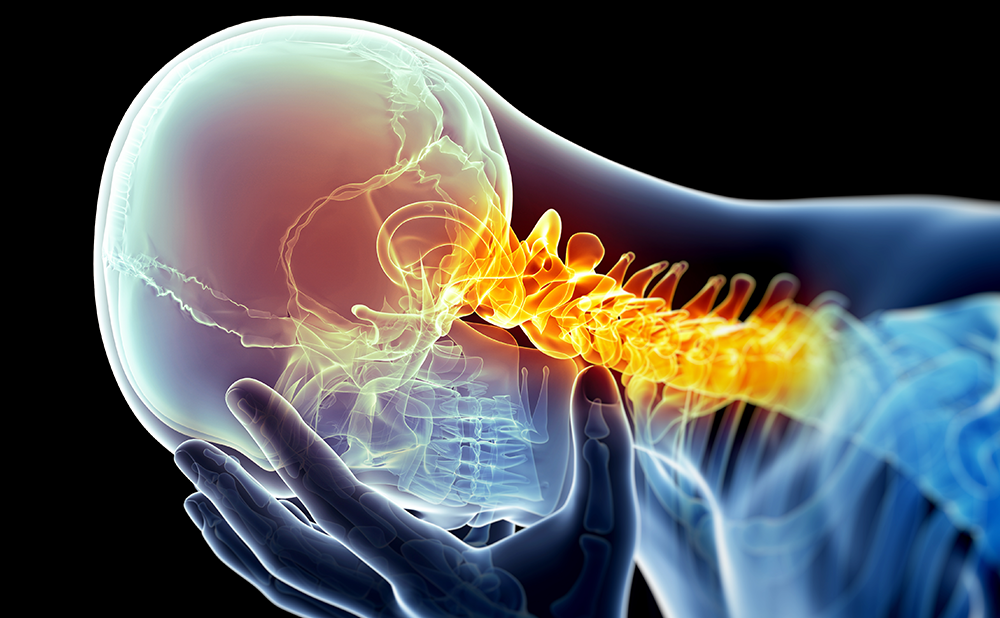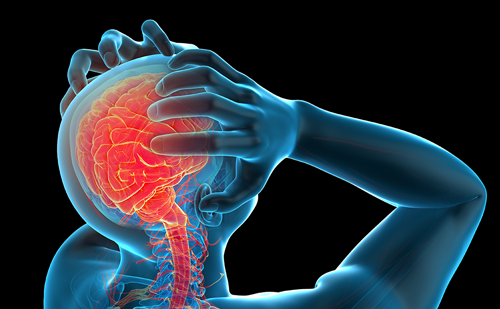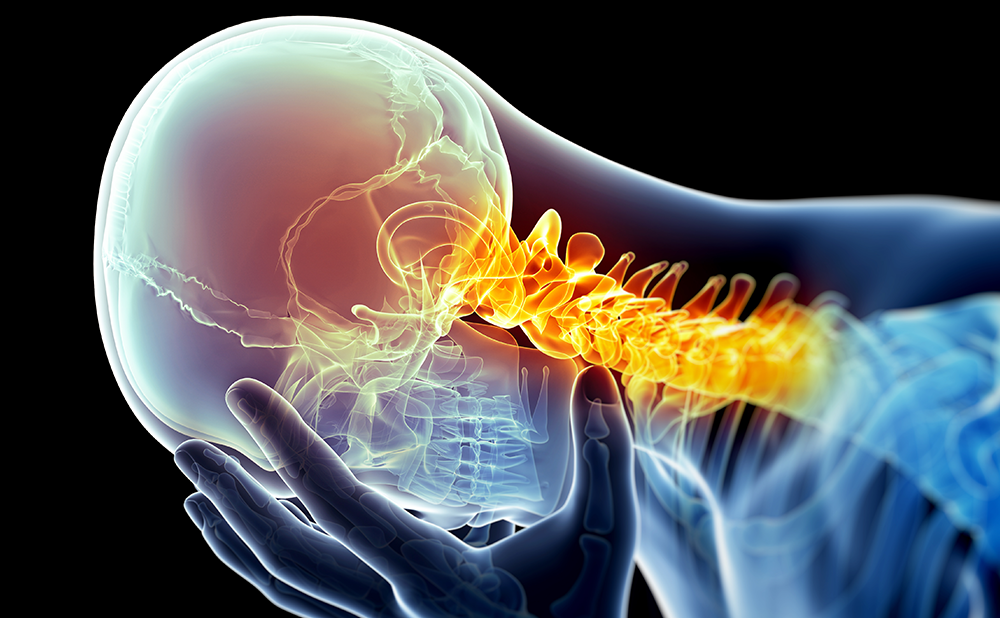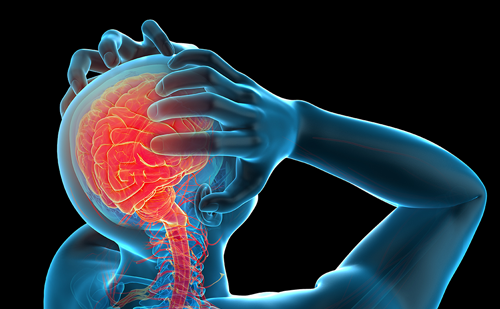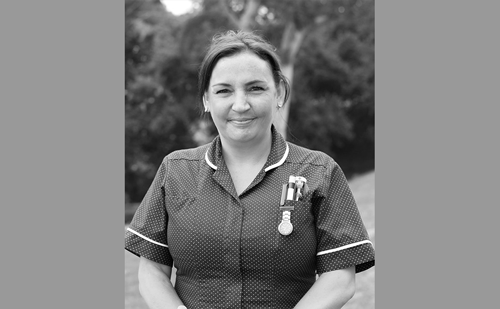Migraine is a common disabling headache disorder, affecting about 12 % of the US and other Western populations. The social and economic impact of the disease is considerable. It is more prevalent in women than in men, and in the age range 30–50 years.1,2
Migraine is a common disabling headache disorder, affecting about 12 % of the US and other Western populations. The social and economic impact of the disease is considerable. It is more prevalent in women than in men, and in the age range 30–50 years.1,2
The choice of acute treatment for migraine has changed over time as the available therapeutic options have increased. In the 1990s the triptans replaced butalbital, opioids and ergot derivatives for the treatment of moderate to severe migraine pain. Even though acute symptomatic therapy can be optimised, migraine remains a chronic and potentially progressive condition.
The Mechanisms of Migraine
The understanding of migraine pathogenesis is currently incomplete, but growing; multiple pathophysiological mechanisms in the peripheral and central nervous system seem to play a role. Interictal susceptibility, aura mechanisms, potential migraine generators and especially cascading molecular events underlying migraine-associated pain and related symptoms must all be taken into consideration in order to understand the medical treatment of migraine attacks.
Migraine may be initiated by neuroinflammation of dural and meningeal trigeminal nociceptors; this phenomenon sensitises peripheral neurons and subsequently results in central trigeminal nucleus caudalis hyperexcitability.3 Glial cells exert important modulatory effects on migraine pathophysiology, influencing neuronal excitability by setting neuronal activation thresholds. Communication between neurons and glial cells increases the expression of pro-inflammatory and nociceptive signalling molecules.4 Calcitonin gene-related peptide (CGRP) released from neuronal cell bodies can stimulate glial cells to release inflammatory cytokines, contributing to the trigeminal sensitisation; in view of this, inhibition of neuronal–satellite glial cell signalling has been postulated as a target mechanism for anti-migraine therapy.5
Cortical spreading depression (CSD) is now generally accepted as the mechanism underlying migraine aura, even though the way in which aura activates headache remains to be established.6 Migraine without aura is thought to be due either to CSD invading ‘silent’ brain areas or to activation of subcortical centres.
CSD increases adenosine 5’-triphosphate and other pro-inflammatory molecules in the cerebrospinal fluid.7,8 It releases nitric oxide (NO)9 and this, by triggering release of CGRP,10 vasodilatation and nociceptor activation, provides a link between neuronal activity and vascular tone.
One consequence of the release of neuroactive substances is neurogenic inflammation, which is accompanied by vasodilatation, disruption of membrane barriers and plasma protein extravasation.11
Hypersensitisation of trigeminal nerve endings may underlie peripheral sensitisation and prolongation of migraine pain. Central sensitisation of the trigeminal system may also contribute to severe prolonged migraine headache pain – this also manifests itself as a return of pain on head movement or scalp pressure after attacks have subsided – and head allodynia.6
The critical importance of central sensitisation is underlined by observations that triptans may be ineffective once allodynia is established.12
General Treatment Principles
The first step in effective migraine management, following confirmation of the diagnosis, is patient education: the condition is carefully explained, to ensure that it is properly understood, and realistic expectations are set. A headache diary will often be very instructive in the planning and evaluation of therapy. Recording affected days, pain severity and medication use and response, as well as obvious triggers (e.g., days of menstrual flow), can be extremely helpful in determining the need for preventive strategies and in the evaluation of therapeutic outcomes.13 Another important factor is migraine-related disability and this can be assessed using the very pragmatic and useful Migraine Disability Assessment Score14 or a similar approach. Together, these aspects help to determine the need for and choice of acute and preventive treatments. Traditionally, the management of migraine is divided into acute or symptomatic treatments and preventive strategies. Patients look for faster onset of relief, more complete relief, no recurrent headache and no adverse events; therefore the goals of acute migraine treatment are to treat attacks rapidly and to prevent their recurrence with minimal or no adverse events, in order to restore the patient’s ability to function.15
To meet these objectives it is important to bear in mind some general principles: the importance of intervening early when the pain is still mild, the need for adequate doses and appropriate routes of administration, and the need for co-administration of antiemetic or prokinetic drugs to facilitate the absorption of the primary drug and guard against chronification of the condition and the development of medication-overuse headache. Indeed, the frequent use of some migraine medications can lead to medication-overuse headache. Both men and women using barbiturates or opiates are at increased risk of developing chronic migraine.16 The critical levels of exposure to opiates and barbiturates are around eight and five days per month, respectively. The use of non-steroidal anti-inflammatory drugs (NSAIDs) has been shown to reduce the risk of progression in patients with low to moderate progression risk (<10 days per month of headache) and to increase this risk in those with a critical headache frequency. Triptan use has also been found to increase the risk of progression in the critical risk group.17,18 These findings underline the need for vigilant monitoring of opiates and barbiturates, and also of NSAIDs associated with caffeine (if prescribed), and the need for close attention to the frequency of headaches.
There exist two main approaches to migraine management: stratified care and step care. In stratified care, treatment is based on measurement of the severity of the disease or other factors, while step care entails the use, first of all, of simple analgesics, progressing over time to more powerful drugs depending on treatment response.
Painkilling drugs currently used in the treatment of migraine fall into two categories: non-specific and migraine-specific preparations. The non-specific drugs are the medications most commonly used to treat mild or moderate migraine attacks and include paracetamol, NSAIDs (alone or in combination with caffeine/caffeine plus prochlorperazine), opioids and barbiturates. Specific drugs, including ergotamine derivatives and triptans, are usually first-line drugs for the treatment of severe migraine attacks.
New and very promising strategies for the acute treatment of migraine, such as CGRP receptor antagonists and serotonin 5-HT1F agonists, are currently in the late stages of clinical trial evaluation.
Analgesics and Non-steroidal Anti-inflammatory Drugs
Simple analgesic drugs or NSAIDs are the drugs of first choice in the presence of mild attacks that have never been known to worsen. Despite the introduction, more than a decade ago, of the triptans, a new class of migraine-specific drugs with superior efficacy, NSAIDs remain the most commonly used migraine attack treatments. A primary and common action of NSAIDs is their inhibition of the synthesis of prostaglandins (PGs) from arachidonic acid, an effect achieved through blocking of cyclo-oxygenase. The effectiveness of NSAIDs in migraine has long been linked to this capacity to inhibit PG synthesis at peripheral level, but recently a central action has also been hypothesised.19 Selective cyclo-oxygenase-2 (Cox-2) inhibitors have also proved effective in migraine treatment, showing similar efficacy to NSAIDs.20 It remains to be established whether Cox-2 inhibitors offer additional advantages beyond their better gastric tolerance; however, frequent use of cyclo-oxygenase inhibitors should be avoided in patients at high cardiovascular risk.
According to a recent review of NSAIDs in the acute treatment of migraine,21 there is evidence that, overall, NSAIDs are effective for the treatment of migraine attacks. Although scientific data on dose–response relationships are scarce, higher doses seem to be more effective. Due to the low number of comparative trials and the small sample sizes in many trials, there is little scientific reason to prefer one NSAID over another, although acetylsalicylic acid (ASA) and NSAIDs such as ibuprofen were, in all available trials, superior to paracetamol. Paracetamol alone was efficient at a dose of 1,000 mg compared with placebo.
Parenteral administration of NSAIDs is an effective treatment for migraine in accident and emergency and in disabling attacks resistant to oral therapies. The NSAIDs with proven efficacy and tolerability (demonstrated in clinical placebo-controlled studies), providing they are used at the recommended doses (see Table 1) and in the absence of contraindications, are: ASA, ibuprofen, diclofenac, metamizole, tolfenamic acid, naproxen sodium and ketoprofen.22
Contraindications for the use of NSAIDs are peptic ulcer and haemorrhagic diathesis. Long-term side effects associated with ASA and other NSAIDs (especially gastric symptoms) are well documented. However, in short-term trials ASA was generally well tolerated. NSAIDs were consistently associated with lower overall adverse event rates when compared with ergotamine; in particular, lower rates of nausea and vomiting were noted.
Antiemetics or prokinetics (such as domperidone 10 mg orally and metoclopramide 10 mg orally or prochlorperazine 3 mg orally) are indicated in addition to analgesics or NSAIDs when treating attacks with severe nausea and vomiting (see Table 2). The oral combination of indomethacin, caffeine and prochlorperazine has been seen to have similar efficacy to oral sumatriptan23 and its rectal formulation was superior to rectal sumatriptan.24 Formulations containing NSAIDs (ASA or paracetamol) with metoclopramide are available in some countries, and paracetamol (1,000 mg) in association with metoclopramide (10 mg) is superior to placebo.25–27 Furthermore, the combination of ASA or paracetamol with caffeine has been shown to be more effective than simple analgesics.
Specific Anti-migraine Drugs
Ergot Derivatives
Ergotamine, introduced in 1926 by Maier,28 was the first drug used for migraine attack treatment. In many countries it is the most widely used specific symptomatic migraine drug, probably because it is inexpensive and has a long duration of action. This drug is used in the treatment of long-lasting attacks with headache recurrence. However, ergotamine can no longer be considered the drug of choice as it carries a high risk of overuse, especially when combined with caffeine; indeed, the addition of caffeine enhances the absorption and possibly the vasoconstrictor action of ergotamine. The drug is associated with a high generalised vasoconstrictor effect if dosing is not carefully monitored.
Like the triptans, ergot derivatives exert an agonist action on serotonin (5-HT) receptors, and this is the reason for their anti-migraine effect. Because of their complex pharmacology and interaction with many other receptors (5-HT1A, 5-HT5, 5-HT2, 5-HT7, α-adrenoceptors and dopamine D2 receptors) beyond their long duration of action, they generate frequent and varied adverse effects (nausea and vomiting are the most common, but also cramps, sleepiness and transient lower limb muscle pain). The powerful and spreading vasoconstrictor action of ergotamine also underlies its contraindications (cardiac and peripheral vascular diseases, hypertension, liver and kidney diseases, sepsis, peptic ulcer, concomitant use of triacetyloleandomycin, pregnancy).
Dihydroergotamine (DHE) is usually better tolerated than ergotamine but has poor oral bioavailability, which reduces its efficacy. Intranasal DHE has better bioavailability (about 40 %) but its onset of action is relatively slow and in two trials, in which it was compared with intranasal and subcutaneous sumatriptan, it was clearly shown to be inferior to the triptan.29,30 Parenteral DHE, i.e. an injectable, intravenous and subcutaneous solution, is more effective in severe migraine attacks but produces more side effects;31 furthermore, in comparison with sumatriptan, it showed lower efficacy for the first two hours, even though it was apparently comparable thereafter.32
Triptans
Since their advent, more than 10 years ago, the triptans, a class of selective and highly effective 5-HT1B/1D receptor agonists, have largely replaced the ergot derivatives. They are potent vasoconstrictors that seem to act on migraine by three main mechanisms: 1) intracranial extracerebral vasoconstriction and inhibition of neurotransmitter release at 2) peripheral as well as 3) central trigeminal nociceptive terminals, mainly via 5-HT1B/1D receptors (trigeminovascular afferents and trigeminal nucleus caudalis).33 Sumatriptan was the pioneer triptan. Later came the development of newer 5-HT1B/1D receptor agonists (zolmi-, nara-, riza-, ele-, almo- and frovatriptan). Known as the second-generation triptans, these drugs effectively penetrate the blood–brain barrier, binding to key structures in central nociceptive areas.6 Although currently available in various formulations (tablets, nasal spray, subcutaneous injection, suppositories), most triptans are effective by the oral route of administration (see Table 3). Sumatriptan offers the most flexibility of formulation.
Many randomised, double-blind, placebo-controlled clinical trials have been performed to demonstrate the efficacy of the triptans in migraine attack treatment and also to define their optimal doses. Head-to-head comparisons of oral triptans have revealed differences in some outcome measures. The choice of triptan and formulation depends on the individual patient’s characteristics, preferences and headache features, as well as on convenience and cost considerations. The individual response to a triptan cannot be predicted. The triptans are most beneficial if they are taken at the very onset of headache, when the intensity of the pain is mild or moderate.34
All the triptans have similar side effects, and variability in this regard depends on the preparation and the route of delivery (side effects are greater with the subcutaneous than with the oral route). The most common side effects are known as ‘triptan sensations’ and they include paraesthesias, flushing, tingling, neck pain and mild transient chest pressure. Switching to a different triptan or another route of administration can mitigate the side effects. Although rare, cardiovascular complications have occurred in treated patients.35
Untreated arterial hypertension, coronary heart disease, Raynaud’s disease, a history of ischaemic stroke, pregnancy, breastfeeding and severe liver or renal failure contraindicate the use of triptans. The administration of other vasoconstrictors, such as ergotamine and its derivatives and also other triptans, is contraindicated within 24 hours of taking a triptan.
Despite the improved pharmacokinetics and pharmacodynamics of this drug class, up to 40 % of all attacks and up to 25 % of patients still fail to respond to triptans. Moreover, headache recurrence (return of pain after initial treatment success) can occur in about 15–40 % of patients taking oral triptans. Criteria for measuring the efficacy of triptans include: degree of pain relief, pain freedom at two hours, sustained pain freedom (pain-free at two hours plus no use of rescue medication and no recurrence within 24 hours) and sustained pain freedom associated with no adverse events. Sustained pain freedom is now widely considered the outcome that most closely reflects patient expectations.34
If switching triptans fails to produce the desired effectiveness, the efficacy of treatment with these drugs could be improved by adding an NSAID. Such combination therapies produce more benefits than either monotherapy or placebo and also reduce headache recurrence, as shown in recent placebo-controlled trials of sumatriptan–naproxen sodium36 and almotriptan–aceclofenac combinations.37 The sumatriptan–naproxen sodium combination is moderately superior to sumatriptan or naproxen monotherapy38 and theoretically able to abort migraine in its initial stages, i.e. at the level of the trigeminal ganglion, and prevent the slow central sensitisation phenomenon.39 For headache recurrence, a second dose of the triptan is effective in most cases.40
One of the most interesting products under development is a sumatriptan patch: NP101 is an iontophoretic patch that delivers sumatriptan transdermally (using a small electric current to drive the compound across the skin) and keeps its plasma levels above the target level of 10 ng/ml for longer than seven hours.41 Transdermal iontophoretic delivery of sumatriptan via NP101 may offer significant clinical benefits for migraine patients, for example, circumventing the gastrointestinal disturbances, including nausea and gastric stasis, that are associated with migraine. The patch also provides consistent, predictable delivery of desired drug levels over a four-hour period. This offers the potential to avoid atypical pain, pressure and other sensations commonly associated with current triptan formulations.42
The combination of triptans with antiemetics is little studied, with only small studies indicating the benefits of this approach. Although one might expect this combination to be helpful, there is no clear clinical evidence that this is the case.43
The Newest Acute Treatment
Calcitonin Gene-related Peptide Antagonists (‘Gepants’)
When specific anti-migraine therapies, i.e. triptans or ergot derivatives, have failed or their use is restricted (by the presence of multiple vascular risk factors or major adverse effects), other non-vasoactive therapeutic alternatives must be offered.
In view of the complex pathogenic mechanisms involved in the migraine attack, considerable efforts have been made to identify other targets for acute therapies.
The most recent experimental and clinical studies have focused on CGRP antagonists. Considering that CGRP receptor antagonists are the first non-serotoninergic, migraine-specific drugs without a vasoconstrictor action, it has been suggested that they may be suitable for patients with vascular disease, such as coronary artery disease and peripheral vascular disease.44
CGRP, one of the most potent vasodilators known, is released from trigeminal sensory nerve fibres. Data from a recent randomised controlled trial confirmed that CGRP antagonists are a potentially useful target in acute migraine treatment.45
Two CGRP antagonists have been studied: olcegepant (BIBN4096), a parenteral preparation, and telcagepant (MK-0974), the first oral formulation. Olcegepant proved to be effective at aborting migraine attacks in a Phase II trial,45 while a Phase IIB study and a Phase III study found telcagepant to work well in migraine. Preclinical studies suggest that telcagepant is not a vasoconstrictor – the vasoconstrictor effect is, as mentioned, a major limitation in the use of triptans – and its efficacy is comparable with that of certain triptans (rizatriptan and zolmitriptan).46 However, a Phase IIa clinical trial of telcagepant for the prophylaxis of episodic migraine was stopped on 26 March 2009 after the “identification of two patients with significant elevations in serum transaminases”.47 A memorandum to the study centres stated that telcagepant had preliminarily been reported to increase the liver enzyme alanine transaminase levels in “11 out of 660 randomised (double-blinded) study participants”. All study participants were told to stop taking the medication. In July 2011, Merck terminated the clinical development of telcagepant.
Other Drugs
5-HT1F Agonists (‘Lasmiditan’)
There are several lines of evidence that implicate the 5-HT1F receptor in migraine. Animal experiments indicate that 5-HT1F agonists are effective in preclinical models of migraine and are not vasoconstrictors.12 LY334370, which is a selective 5-HT1F agonist, inhibits single-cell firing in the trigeminal nucleus caudalis without having any effect on the cerebral vessel lumen as measured by intravital microscopy.48 Anatomically, 5-HT1F mRNA is located in the trigeminal ganglion. Functionally, 5-HT1F, 5-HT1B and 5-HT1D agonists can presynaptically inhibit the release of glutamate, which may participate in the migraine cascade.49 Clinically, LY334370 is the prototype selective 5-HT1F agonist and also the first one to reach Phase II clinical development.49,50 Adverse events found to be more common on oral LY334370 than on placebo were asthenia, somnolence, dizziness and paraesthesias.51
5-HT1D Agonists (PNU-109291 and PNU-142633)
5-HT1D receptor agonists are potent inhibitors of dural plasma protein extravasation and possess no vasoactive properties. Two 5-HT1D selective agonists (PNU-109291 and PNU-142633) have shown some promise in animal models of migraine. In one human randomised controlled trial, PNU-142633 failed to achieve significance and subjects reported cardiovascular symptoms such as chest pain.52 The PNU-142633 programme was abandoned. Also, the non-vasoactive hypothesis of 5-HT1D agonism needs further elucidation in view of the complaints of chest symptoms on PNU-142633. One tantalising hypothesis is that 5-HT1D agonists are cardioactive but not vasoactive and the chest symptoms are valvular in origin since 5-HT1D receptors are found on cardiac valves.53 Another explanation is that the chest symptoms are of pulmonary origin.54
Glutamate Modulators
Ramadan et al., in 2003, discussed the role of glutamate in migraine pathophysiology.49 The fact that neurons in the trigeminal ganglion that are 5-HT1B, 5-HT1D and 5-HT1F receptor-positive are also glutamate receptor-positive could indicate that 5-HT1 autoreceptors inhibit the release of glutamate presynaptically.55 Two studies demonstrated elevated plasma levels of glutamate in migraine patients, particularly in migraine-with-aura patients, but these results were not confirmed by other studies.
Beyond their vascular effects, drugs modifying glutamate neurotransmission and modulation are promising in migraine therapy for other reasons: one need only consider the multiple stages in the pathophysiological cascade of migraine in which glutamate and its receptors have a pivotal action in experimental models, from CSD to processing of nociceptive information in the trigeminovascular pathway.56
NXN-188 is a new oral agent with a dual mechanism of action: inhibition of neuronal NO synthase and binding to 5-HT1B/1D receptors. The results of a Phase II trial were rather disappointing, in that NXN-188 failed to produce pain relief at two hours; however, statistically significant responses were obtained for pain freedom, sustained pain freedom and use of rescue medication.57
Finally, there is also evidence of efficacy of a dopamine antagonist (intramuscular droperidol)58 and a vanilloid receptor modulator (civamide)59 in acute migraine pain.
Conclusion
The choice for acute treatment in migraine represents a crucial role, not only in pain managing but also in providing the patient a better control of the quality of life. Therapeutical tools have changed over time when newly available options are introduced. Triptans represented a breakthrough in migraine treatment, because of their efficacy, rapidity of action and tolerability. Considering their limited prescription for a relatively small group of patients (vasoconstriction activity), the scientific community is moving forward and looking for alternatives without vascular actions. Calcitonin gene-related peptide receptor antagonists (‘Gepants’) are now a promising non-vasoconstrictor option. Other opportunities may be offered by 5-HT1F agonist, 5-HT1D agonist, glutamate modulators, nitric oxide synthase inhibitors, vanilloid receptor modulator and dopamine antagonist. More controlled studies using the above therapeutical approaches are needed to confirm their efficacy and provide a better quality of life of migraine patients. ■


